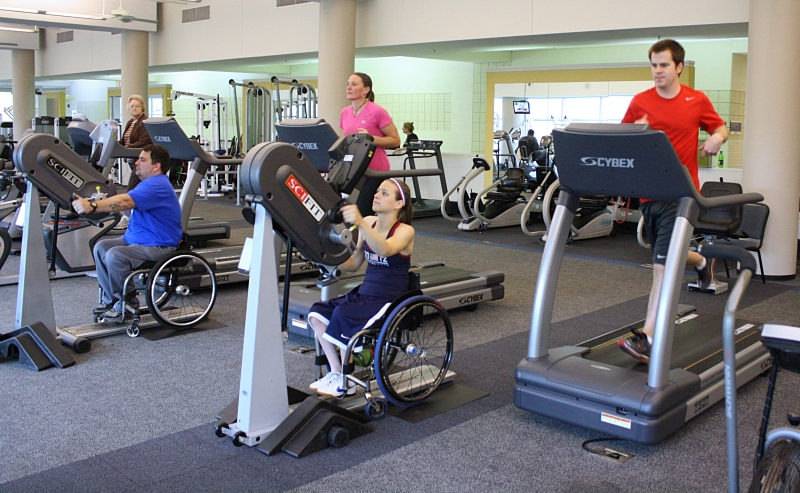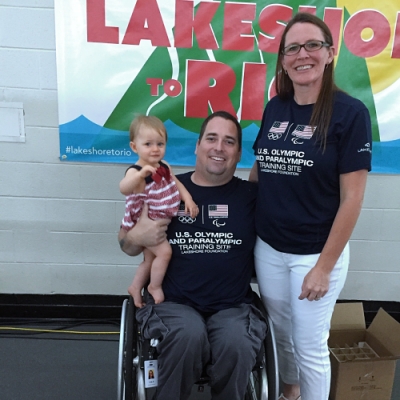Kelly Bonner |
April
9, 2020

The Kelly Bonner story: How I got involved with inclusive exercise and what drives me today.
Resources and Free CEC Courses Listed Below
An average trainer creates a program they hope their client will enjoy. A good trainer gets to know their client, their likes, what they can do, and how far to push them without pushing them away. They create a program they know their client is going to love. The only thing you need to train someone with a disability is a good trainer.
I grew up loving movement and the science behind it. While all my high school friends were taking marine biology so they could have class at the beach, I was sitting in a semidark classroom that reeked of formaldehyde, taking anatomy and physiology and loving every minute of it. In college, I knew exactly what I wanted to major in from day one, but I didn’t just want to learn about it; I wanted to practice it as well.
As a college athlete, I gained my freshman 15 and then dropped it during two-a-days where trips to the restroom became an act of faith that something would be there to catch me as I fell because my quads were too shot to do the work themselves. Later, when it was time for my internship and as an athlete juggling classes, practices, and everything else that comes with college life, I signed up for the one closest to our campus, which just so happened to be at a gym for people with physical disabilities. I didn’t know the first thing about disabled people, but I figured I could always change locations the next semester when my sport was out of season if I felt like I was in over my head. Little did I know that walking in that door the first day would ignite a new passion.
 During the first few days, I met an older gentleman missing a leg, a guy about my age who had recently acquired quadriplegia, a woman who was just starting to realize the effects of her ataxia, and a man who only had the use of one side of his body after experiencing a stroke. Everyone there had a different story. Some were born with their disabilities, some acquired them through more traumatic events, and others aged into them. And everyone there was just like every other client in every other gym. Some were there to lose weight, some were athletes looking to improve their game, and some just wanted to maintain their current level of independence or fitness. Some were there to exercise, some were there to socialize, and some, it seemed, were just there to complain.
During the first few days, I met an older gentleman missing a leg, a guy about my age who had recently acquired quadriplegia, a woman who was just starting to realize the effects of her ataxia, and a man who only had the use of one side of his body after experiencing a stroke. Everyone there had a different story. Some were born with their disabilities, some acquired them through more traumatic events, and others aged into them. And everyone there was just like every other client in every other gym. Some were there to lose weight, some were athletes looking to improve their game, and some just wanted to maintain their current level of independence or fitness. Some were there to exercise, some were there to socialize, and some, it seemed, were just there to complain.
It’s been more than 20 years since that first day and, looking back, I can remember being intimidated the first time I had to work with someone one-on-one, unsure if I would know what to do. But I quickly realized all it took was for me to be a good trainer and to put into practice the things I was learning in school. But more than that initial intimidation or fear of the unknown, I remember those moments that forever changed me as a personal trainer.
I remember working with someone who had been injured in the military and helping him see he could still be active with his kids. That was when I realized that what I do isn’t just about what happens in the gym.
Or the time I trained a woman to compete in her first 5K from a wheelchair and I realized that, for the most part, training for a 5K was the same seated or standing. The goal is simply to cross the finish line.

I also recall being new to the world of disability sports and excitedly telling a young guy with a new spinal cord injury about how he qualified to play. He quickly put me in my place and told me that wasn’t something he was excited about at the time. Thankfully that guy forgave my ignorance and is now my husband of 10 years, but I realized that day that not everyone is in the same place when it comes to how they feel about their disability.
Finally, I remember the time I took a client outside to my SUV and helped her learn how to transfer into my car so that she could ride with anyone she wanted, including her son. I realized that when I stopped and listened long enough to the real needs of a client, I could create a program that not only made them strong enough to do everyday activities, but one that changed their life.
I could go on and on. I didn’t think of my job as special or unique; I thought of everyone else’s as boring. I mean, how hard is it to design an exercise program for someone who can move all their limbs? Sarcasm aside, did you know 1 in 4 people in the U.S. has a disability? With those numbers it seems it would be hard not to serve individuals with a disability, not to mention a poor business decision.
 After years of working at Lakeshore Foundation and loving it, I was approached by the associate director of the National Center on Health Physical Activity and Disability (NCHPAD) to come work for them. NCHPAD had just moved from Chicago, Illinois to our campus in Birmingham, Alabama, and I was skeptical at first. Not only did I love my job at Lakeshore, but I had never had a desk job and didn’t know how I would fare. After initially only agreeing to part-time work, I soon discovered I was hooked and wanted more.
After years of working at Lakeshore Foundation and loving it, I was approached by the associate director of the National Center on Health Physical Activity and Disability (NCHPAD) to come work for them. NCHPAD had just moved from Chicago, Illinois to our campus in Birmingham, Alabama, and I was skeptical at first. Not only did I love my job at Lakeshore, but I had never had a desk job and didn’t know how I would fare. After initially only agreeing to part-time work, I soon discovered I was hooked and wanted more.
With NCHPAD, I was able to take what I had learned on the fitness floor for the previous 15 years and put it out on a national platform and help other trainers see that working with clients with a disability really wasn’t all that different. My years of being an adjunct professor at my alma mater, Samford University, also proved useful in this new position as I started taking on more and more training opportunities. Now I am the Project Coordinator of Training and Education for the National Center and lead all of our training projects, including the Inclusive Fitness Trainings that correspond with the ACSM/NCHPAD Certified Inclusive Fitness Trainer (ACSM/NCHPAD-CIFT) certification.
I still wake up and love what I do every single day. I think the most important thing I have learned during the last 20 years is that a person with a disability is just a person and to be able to train them just takes a good trainer. Be respectful and treat them like you would like to be treated. Is it really all that inspiring that they decided to come to the gym today or are they just like you and me? And don’t take their parking spot or their bathroom stall; we have options, they don’t. Now, go out and be a good trainer.
If you would like to learn more about NCHPAD check out these links:
What is NCHPAD: video
Resources for Fitness Professionals: video and web-based
Disability Education | 1.0 CECs
Fitness Professionals | 1.0 CECs
Fitness Assessments for Individuals who use a Wheelchair | 1.0 CECs
ACSM/NCHPAD Certified Inclusive Fitness Trainer
Author:

Kelly Bonner
Project Coordinator of Training and Education, National Center on Health Physical Activity and Disability
View ACSM Specialty Certifications